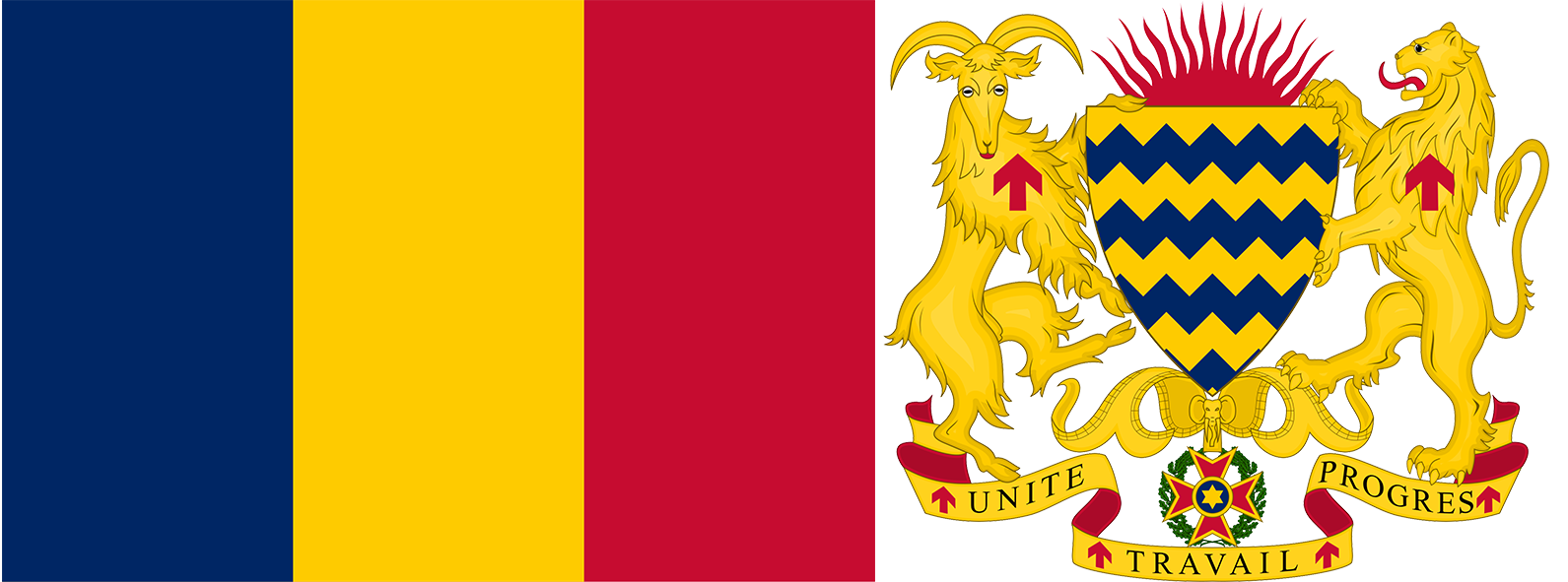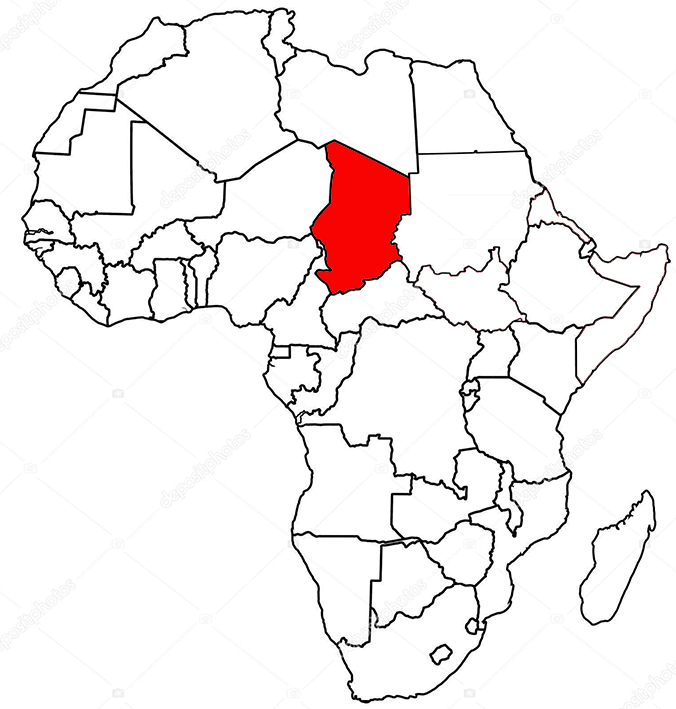FabulousFusionFood's Chadian recipes Home Page
 The flag of Chad (left) and the Coat of Arms (right).
The flag of Chad (left) and the Coat of Arms (right).
Welcome to the summary page for FabulousFusionFood's Chadian recipes, part of the African Continent. This page provides links to all the Chadian recipes presented on this site, with 17 recipes in total.
Chad, officially: the Republic of Chad, is a landlocked country in Central Africa. The capital and largest city is N'Djamena.
Millet forms the basis for many Chadian staples, as does sorghum. The main protein source is fish, though beef and chicken also form a significant part of the diet. Stews are often made with okra and cassava leaves are the main greens. The most common ingredients in Chadian cuisine are local fruit, rains and vegetables, milk and meat products.
Chad, officially the Republic of Chad (جمهورية تشاد in Arabic and République du Tchad in French) s a landlocked country located at the crossroads of North and Central Africa. It is bordered by Libya to the north, Sudan to the east, the Central African Republic to the south, Cameroon to the southwest, Nigeria to the southwest (at Lake Chad), and Niger to the west. Chad has a population of 16 million, of which 1.6 million live in the capital and largest city of N'Djamena. With a total area of around 1,300,000 km2 (500,000 sq mi), Chad is the fifth-largest country in Africa and the twentieth largest nation by area in the world.
 The image above shows Chad in (red) in relation to Africa.Chad has several regions: the Sahara desert in the north, an arid zone in the centre known as the Sahel and a more fertile Sudanian Savanna zone in the south. Lake Chad, after which the country is named, is the second-largest wetland in Africa. Chad's official languages are Arabic and French. It is home to over 200 different ethnic and linguistic groups. Islam (55.1%) and Christianity (41.1%) are the main religions practiced in Chad.
The image above shows Chad in (red) in relation to Africa.Chad has several regions: the Sahara desert in the north, an arid zone in the centre known as the Sahel and a more fertile Sudanian Savanna zone in the south. Lake Chad, after which the country is named, is the second-largest wetland in Africa. Chad's official languages are Arabic and French. It is home to over 200 different ethnic and linguistic groups. Islam (55.1%) and Christianity (41.1%) are the main religions practiced in Chad.
Beginning in the 7th millennium BC, human populations moved into the Chadian basin in great numbers. By the end of the 1st millennium AD, a series of states and empires had risen and fallen in Chad's Sahelian strip, each focused on controlling the trans-Saharan trade routes that passed through the region. France conquered the territory by 1920 and incorporated it as part of French Equatorial Africa. In 1960, Chad obtained independence under the leadership of François Tombalbaye. Resentment towards his policies in the Muslim north culminated in the eruption of a long-lasting civil war in 1965. In 1979 the rebels conquered the capital and put an end to the South's hegemony. The rebel commanders then fought amongst themselves until Hissène Habré defeated his rivals. The Chadian–Libyan conflict erupted in 1978 by the Libyan invasion which stopped in 1987 with a French military intervention (Operation Épervier). Hissène Habré was overthrown in turn in 1990 by his general Idriss Déby. With French support, a modernization of the Chad National Army was initiated in 1991. From 2003, the Darfur crisis in Sudan spilt over the border and destabilised the nation. Already poor, the nation and people struggled to accommodate the hundreds of thousands of Sudanese refugees who live in and around camps in eastern Chad.
The name of the country Chad was based on a linguistic a mistake. In the eighteen-hundreds, European explorers arrived at the marshy banks of a vast body of freshwater in Central Africa. Because locals referred to the area as chad, the Europeans called the wetland Lake Chad, and drew it on maps. But chad simply meant “lake” in a local dialect.
Chadians use a medium variety of grains, vegetables, fruits and meats. Commonly consumed grains include millet, sorghum, and rice as staple foods. Commonly eaten vegetables include okra and cassava. A variety of fruits are also eaten. Meats include mutton, chicken, pork, goat, fish, lamb and beef. The day's main meal is typically consumed in the evening on a large communal plate, with men and women usually eating in separate areas. This meal is typically served on the ground upon a mat, with people sitting and eating around it.
Chad, officially: the Republic of Chad, is a landlocked country in Central Africa. The capital and largest city is N'Djamena.
Millet forms the basis for many Chadian staples, as does sorghum. The main protein source is fish, though beef and chicken also form a significant part of the diet. Stews are often made with okra and cassava leaves are the main greens. The most common ingredients in Chadian cuisine are local fruit, rains and vegetables, milk and meat products.
Chad, officially the Republic of Chad (جمهورية تشاد in Arabic and République du Tchad in French) s a landlocked country located at the crossroads of North and Central Africa. It is bordered by Libya to the north, Sudan to the east, the Central African Republic to the south, Cameroon to the southwest, Nigeria to the southwest (at Lake Chad), and Niger to the west. Chad has a population of 16 million, of which 1.6 million live in the capital and largest city of N'Djamena. With a total area of around 1,300,000 km2 (500,000 sq mi), Chad is the fifth-largest country in Africa and the twentieth largest nation by area in the world.
 The image above shows Chad in (red) in relation to Africa.
The image above shows Chad in (red) in relation to Africa.Beginning in the 7th millennium BC, human populations moved into the Chadian basin in great numbers. By the end of the 1st millennium AD, a series of states and empires had risen and fallen in Chad's Sahelian strip, each focused on controlling the trans-Saharan trade routes that passed through the region. France conquered the territory by 1920 and incorporated it as part of French Equatorial Africa. In 1960, Chad obtained independence under the leadership of François Tombalbaye. Resentment towards his policies in the Muslim north culminated in the eruption of a long-lasting civil war in 1965. In 1979 the rebels conquered the capital and put an end to the South's hegemony. The rebel commanders then fought amongst themselves until Hissène Habré defeated his rivals. The Chadian–Libyan conflict erupted in 1978 by the Libyan invasion which stopped in 1987 with a French military intervention (Operation Épervier). Hissène Habré was overthrown in turn in 1990 by his general Idriss Déby. With French support, a modernization of the Chad National Army was initiated in 1991. From 2003, the Darfur crisis in Sudan spilt over the border and destabilised the nation. Already poor, the nation and people struggled to accommodate the hundreds of thousands of Sudanese refugees who live in and around camps in eastern Chad.
The name of the country Chad was based on a linguistic a mistake. In the eighteen-hundreds, European explorers arrived at the marshy banks of a vast body of freshwater in Central Africa. Because locals referred to the area as chad, the Europeans called the wetland Lake Chad, and drew it on maps. But chad simply meant “lake” in a local dialect.
Chadian Cuisine
Millet is the staple food of Chadian cuisine. It is used to make balls of paste that are dipped in sauces. In the north this dish is known as alysh; in the south, as biya. Fish is popular, which is generally prepared and sold either as salanga (sun-dried and lightly smoked Alestes and Hydrocynus) or as banda (smoked large fish). Carcaje is a popular sweet red tea extracted from hibiscus leaves. Alcoholic beverages, though absent in the north, are popular in the south, where people drink millet beer, known as billi-billi when brewed from red millet, and as coshate when from white millet.Chadians use a medium variety of grains, vegetables, fruits and meats. Commonly consumed grains include millet, sorghum, and rice as staple foods. Commonly eaten vegetables include okra and cassava. A variety of fruits are also eaten. Meats include mutton, chicken, pork, goat, fish, lamb and beef. The day's main meal is typically consumed in the evening on a large communal plate, with men and women usually eating in separate areas. This meal is typically served on the ground upon a mat, with people sitting and eating around it.
The alphabetical list of all Chadian recipes on this site follows, (limited to 100 recipes per page). There are 17 recipes in total:
Page 1 of 1
| Boule de Petit Mil (Fonio Balls) Origin: Chad | Jarret de Boeuf Origin: Chad | Les Cakes (Chadian Biscuits) Origin: Chad |
| Brochette de Poisson Tchadienne (Chadian Fish Kebabs) Origin: Chad | Karkanji Origin: Chad | Moula Kawal (Kawal Sauce) Origin: Chad |
| Cailles au Paprika (Quails in Paprika Sauce) Origin: Chad | Koumrangan Origin: Chad | Purée d'Oseille (Hibiscus Leaf Purée) Origin: Chad |
| Cossey (Bean Fritters) Origin: Chad | La Bouillie Origin: Chad | Sauce Koumrangan (Hibiscus Leaf Sauce) Origin: Chad |
| Daraba Origin: Chad | Le Kissar Origin: Chad | Sauce Moundourou (Moundourou Leaf Sauce) Origin: Chad |
| Gombo et Kissar (Okra Stew with Kissar) Origin: Chad | Le Koki (Bean Cake) Origin: Chad |
Page 1 of 1